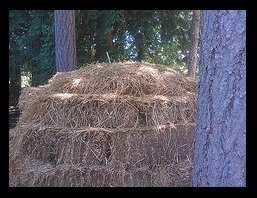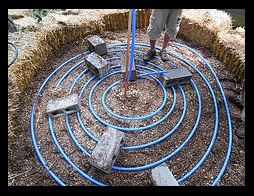RAD is consistently remodeling dorm buildings, and the Sustainability crew role is to weigh in on green materials and products. As a part of the MOD remodels, we try to find a way to implement an alternate energy system. This summer we remodeled MOD 311, and installed a radiant in-floor heat system. This is an extremely efficient way to heat a home. The way the system works is hot water is run through pipes that loop underneath the floorboards. This heat “radiates” up, heating the floor and everything in contact with the floor, rather than the air. This gives the room the illusion of being warmer than it is, meaning you can set your thermostat to a lower temperature without getting cold. However, MOD 311 is not your average in floor radiant system. We chose to implement a unique way of heating the water to be run through the pipes.
In a system modeled after a design by Jean Pain, a french innovator born in 1930, we built a heat generating compost pile. The pile is a mixture of 60% fir shavings, 30% alder sawdust, and 10% horse manure. Several layers of water pipe run throughout the pile, and the heat generated by the decomposition process is transferred to the water inside the pipes. We also put a layer of hay bales around the whole structure, which helps keep heat and moisture in. Keeping the pile wet is imperative to the health of the microorganisms that generate the heat.
The pile starts the school year at about 150 degrees Fahrenheit, which translates to roughly 145 degree water. The radiant heat system requires water that ranges from 110-130 F, so the excess heat can be used for showers, washing dishes, or doing a load of laundry. Don’t worry; it’s a closed system, so the water never comes in contact with the compost.
The overall temperature of the pile will slowly decrease over the course of the year, and should be at about 100 degrees by the end of the spring quarter. This may not be hot enough to completely cover the MOD’s heating needs, but considering the water enters the system at about 50 degrees Fahrenheit, it’s still a huge energy savings. And at the end of the year, all the material used to build the pile has broken down into a nutrient rich compost that can be utilized on the gardens around campus. This just leaves all the hardware involved, like the pipes and the water pumps, which can be used time and time again to build new piles every year. The pile is hard to miss if you’re by MOD 311, so come down and take a peak!
A special thanks goes to Gaelan Brown of Compostpower.org, who flew all the way from Vermont to help us with the project. He’s been building these piles for years all over the world, and if you’re interested in learning more about compost heat, his website is an excellent resource. It even includes the step by step guide we used to build your own system!


I’m planning a compost heat system in Olympia. Would someone be willing to get together with me and discuss some design questions?
Yes we would be happy to. email RADsustainability@evergreen.edu to get a hold of us directly. That is the RAD sustainability Email address.